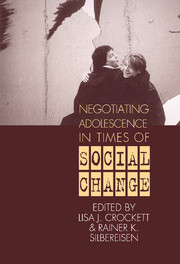Book contents
- Frontmatter
- Contents
- Contributors
- Preface
- 1 Social Change and Adolescent Development: Issues and Challenges
- Part I Models of Social Change Effects
- Part II Social Change and Adolescent Transitions
- Part III Social Change and Adolescents' Social Contexts
- 9 Adolescent Peer Relations in Times of Social Change
- 10 Life Course Dynamics and the Development of New Relations Between Generations
- 11 A Neighborhood-Level Perspective on Social Change and the Social Control of Adolescent Delinquency
- 12 Social Change and the “Social Contract” in Adolescent Development
- Part IV Implications of Social Change for Adolescent Health and Well-Being
- Part V Interventions: Promoting Healthy Development in Times of Social Change
- Endnotes
- Index
11 - A Neighborhood-Level Perspective on Social Change and the Social Control of Adolescent Delinquency
Published online by Cambridge University Press: 26 January 2010
- Frontmatter
- Contents
- Contributors
- Preface
- 1 Social Change and Adolescent Development: Issues and Challenges
- Part I Models of Social Change Effects
- Part II Social Change and Adolescent Transitions
- Part III Social Change and Adolescents' Social Contexts
- 9 Adolescent Peer Relations in Times of Social Change
- 10 Life Course Dynamics and the Development of New Relations Between Generations
- 11 A Neighborhood-Level Perspective on Social Change and the Social Control of Adolescent Delinquency
- 12 Social Change and the “Social Contract” in Adolescent Development
- Part IV Implications of Social Change for Adolescent Health and Well-Being
- Part V Interventions: Promoting Healthy Development in Times of Social Change
- Endnotes
- Index
Summary
This chapter explicates the central ideas animating a neighborhood-level approach to what is often treated as a purely “familial” or within-household phenomenon: informal social control. I first outline a theory of neighborhood social control with a focus on the role of social change reflected in concentrated structural disadvantage and patterns of residential instability. Specifically, I examine how unexpected changes in concentrated disadvantage and residential instability relate to variations in informal social control at the neighborhood level. In turn, I provide a preliminary assessment of the mediating role that informal social control plays in the explanation of rates of adolescent delinquency. The data are taken from a recent multilevel study of 80 neighborhoods in Chicago.
Social Disorganization and Social Control
My conceptual framework begins with the classic “Chicago School” tradition of urban sociology pioneered by Robert Park and Ernest Burgess (1921) and later extended by Clifford Shaw and Henry McKay. In Juvenile Delinquency and Urban Areas, Shaw and McKay (1942) argued that three structural factors – low economic status, ethnic heterogeneity, and residential mobility – fostered the disruption of community social organization, which in turn accounted for variations in crime and delinquency rates. Social disorganization is conceptualized as the inability of a community structure to realize the common values of its residents, and hence, to maintain effective social controls (Kornhauser, 1978; Bursik, 1988). As Janowitz (1975) has argued, social control refers to the capacity of a social unit to regulate itself according to desired principles – to realize collective, as opposed to forced, goals.
- Type
- Chapter
- Information
- Negotiating Adolescence in Times of Social Change , pp. 178 - 190Publisher: Cambridge University PressPrint publication year: 1999
- 1
- Cited by



